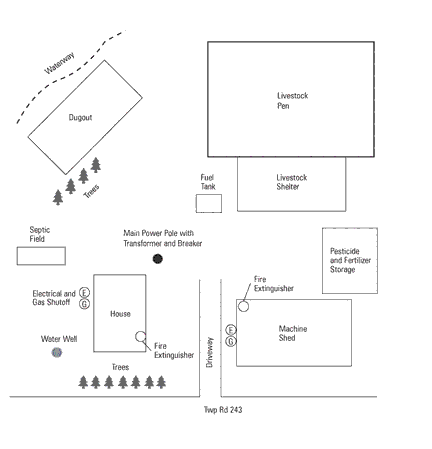| | Emergency Planning, Clean-up and Handling Procedures
Every farmstead needs an emergency plan that outlines the location and identification of hazardous materials, emergency equipment, telephone numbers and necessary clean-up methods. Such a plan gives those living on the farmstead guidelines to follow for minimizing potential environmental damage to the site, as well as protecting those living on the site and in the surrounding community.
An emergency plan for your farmstead should be made accessible to others who visit or work on the farm. Emergency response teams should also have access to the plan to help them distinguish between response procedures for different situations.
In the case of spills with hazardous sources such as pesticides, fuel, fertilizer, or livestock manure, those living and working on the farmstead need to be responsible for minimizing environmental and safety risks by following these steps:
- Isolating the affected area
- Wearing protective clothing
- Ventilating the area
- Stopping further leaks
- Containing the spill area
- Reporting the spill
- Cleaning the spill
- Decontaminating the spill area
- Disposing and reclaiming the waste
To ensure human health and safety, protect the environment and prevent a more extensive problem, report all spills (immediately if entering or threatening a water body or source). Reporting a spill provides information if clean up is required. It also provides a record in case the incident is reported by someone else and leads to an investigation that may result in costly sample taking and associated chemical analyses to determine what has been spilled.
In the case of a non-hazardous, accidental spill, it is always a good idea to carry a supply of fresh water and a clean pair of gloves to wear when cleaning up. First, it is important to read any product labels or contact the manufacturer for advice on clean-up procedures (most products have a 1-800 customer service number on the label). Disposing of all absorbent materials must be done in an approved landfill. If the spill is large, evacuate the area and notify Alberta Environment through their Emergency Response Centre at 1-800-222-6514.
Mapping out your farmstead site may be a good first step to identifying potential hazardous areas (see Figure 1). The following diagram outlines where all buildings are located in proximity to roads, dugouts, fuel tanks, corrals or animal shelters. Main power poles with transformers and breakers should also be included. In addition, be sure to include anything that can become a hazard on the map:
- compressed gas storages (oxygen, acetylene and air tanks)
- fuels and oils
- electrical, gas and water shutoffs
- water well locations (including abandoned and unused wells) and water sources (including dugouts)
- fertilizer and pesticide storages, as well as mixing and loading areas
- compost and manure storage areas
- farm waste storage areas
- septic systems
- fire fighting equipment such as fire extinguishers

Figure 1. Farmstead map of potential hazards and sources
For More Information:
All Alberta government offices may be reached toll-free by dialing the Rite Line: 310-0000
Alberta Agriculture and Rural Development
Alberta Farm Safety Program: 780-427-4231
- Handling Pesticides: Are You Protected?
- Safe Handling of Agrochemicals
Ag-Info Centre: 310-FARM (3276)
Website: www.agric.gov.ab.ca
Alberta Municipal Affairs
Fire Commissioner’s Office: 780-427-8392Field Technical Services: 1-866-421-6929
Website: www.municipalaffairs.gov.ab.ca
Sustainable Resource Development
Publications: 780-427-2700
- FireSmart Manual: Protect Your Home From Wildfire, 3rd Edition SRD-025-IC
Forest Fire Line: 310-FIRE (3473)
Website: www.srd.gov.ab.ca
Alberta Environmental Farm Plan Company
Office: 1-866-844-2337
Website: www.albertaefp.com |
|